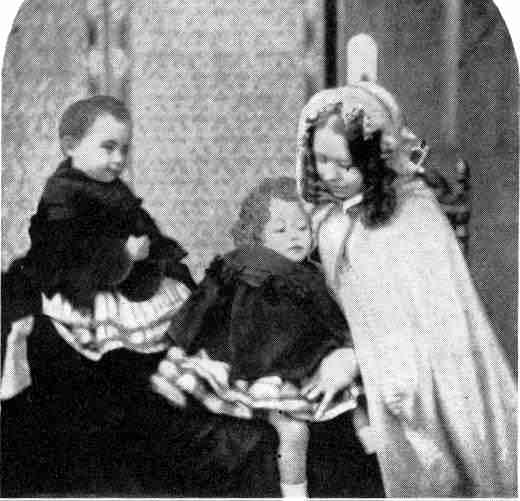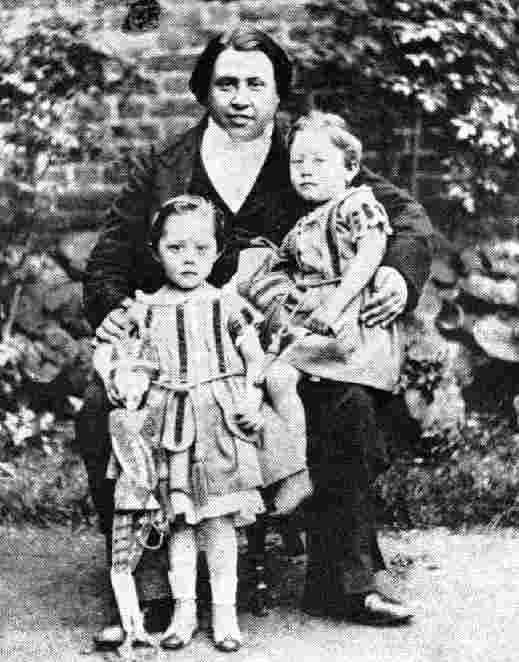
Biography: Charles Haddon Spurgeon (England, 1834-92)

Figure 1.--While no images are avaialble on the young Charles Haddon Spurgeon in the 1830s and 1840s, there are inages on his two twin sons from the 1850s and 1860s. The boys are pictured here in dresses, probably about 1858. Note how the boys seem to have different hair cuts--quite unusual.
|
|
Spugeon was a noted English Baptist praecher, sometimes referred to as the Prince of Preachers. He was born in Kelvedon, Essex. His father was a preacher and he was an excellent student. He wore pinafores at his dame school. At his subsequent school he antagonized both his school mates and an uncle who was a
teacher. He went on to fame and his followers built the Metropolitan Tabernacle in London. He had twin sons who wore dresses as children.
Family
Charles' grandfather and father were both preachers. Much of his religious training came from them. His parents were Congregationalists.
Father
John Spurgeon (1810-1902) was the second son of the pastor at Stambourne. The Spurgeon family had preached at Stambourne since the 17th century. Religion was apparently in the family blood. Charle's father recalled me like Job Spurgeon who endured harsh imprisonment under Charles II because of his Nonconformity.
Mother
John Spurgeon mairred Aliza Jarvis (1815- ). Charles lived with him mother's family in Colchester. His father was a pastor 9 miles away where he also did the accounts forva coal mine to make ends meet.
Brothers and sisters
Charles was no lonely as a boy. By the age of 5 he had two sisters and a brother--James. Charles was the natural leader.
Childhood
He was born in Kelvedon, Essex on on June 19, 1834. One of his earliest memories was darkness. England in his childhood had a window tax. So his father had plastered up some of the windows of the parsonage to reduce his taxes. A small town preacher had little money for luxuries. Some of tghe other windows had boards saying "dairy" and "chesse room" and thus exempt from the tax. He also recalls a grey rocking-horse, the only horse he ever enjoyed riding. It could be riden astride or side-saddle. [Spurgeon, The Early Years, pp. 3-4]
Most of his childhood memories revolved around his granfdfather's preaching and his father's lectures. As a boy he was required to sit in the parlor and be quiet while his grandfather prepared the sermons. For diversion he was given the Evangelical Magazine. Aparrently he did not find it very duiverting.
In his youth, Charles was very early impressed with things divine, and after several years under the weight of sin, Spurgeon was convicted and converted to Christ at the age of 15 while listening to an uneducated Primitive Methodist layman, speaking to a small group, roughly comment upon Isaiah 45:22. Charle's godly mother later said to him, "Ah, Charles! I often prayed the Lord to make you a Christian, but I never asked that
you become a Baptist." Spurgeon could not resist the temptation to reply, "Ah, mother! The Lord has answered your prayer with His usual bounty, and
given you exceeding abundantly above what you asked or thought."
Childhood Clothing
Very little information is available on Charles' boyhood clothes. He was born at a time that photography had not been developed. A photograph or a painted portrait were outside the budget of a country preacher. Charles in his autobiography does remember wearing pinafores at his dame school. He does not further describe his clothesm but the oinafores are described matter of factly. [Spurgeon, The Early Years, p. 23] This suggests that it was normal atire for the girls and boys at the dame school.
The only other reference to clothing concerned his brother who he claimed had weak ankles and was always falling down. This would get him into trouble at home, no doubt because clothes were expensice and the budget very limited. Their father thought it was simple carelessness and threatened to whip him every time he came hime with his clothes showing that he had fallen down. Years later Charles reminded his father of this. His father recalled triumphantly how well te regulkation had worked. Charles explained, however, that his brother kept having tumbles, but "I always managed to wash his knees, and to brush his clothes, so a to remove all traces of his falls." [Spurgeon, The Early Years, p. 24] Unfortunately, Spurgeon does not tell us just what he and his brither were wearing. As they were both apparently going to the danme school, pinafores are a possibility. As Spurgeon specifically mentions washing his brother knees, the boys are at least the younger brother clearly was not wearing either long pants or long stockings.
Education
Charles was an excellent student. He first attended a dame school in Stambourne. He recalls that it was taught by old Mrs. Burleigh. Upon learning her som was Gabriel, he was disappointed to find, when they met, that Gabriel had no wings and wore trousers. Upon returning to Colchester he attended another dame school run by Mrs. Cook until he was 10.
Charles then attended Stockwell House School which provided him a good middle class education. He was particularly impressed by a Lr. Leeding. He impressed the other boys with his academic talents, Spurgeon and his brother James were sent to a college in Maidstone in 1848 where his uncle taught. He managed to antagonized both his school mates and an uncle who was a teacher. He atagonized his uncle by correcting his math before the other students, after with Charles was assigned math work to do by himself. His uncle, however, when a boy was to be punished, would send Charles out to get a switch. Charles soon noticed that "I never once succeeded in selecting a stick which was liked by the boy who had to feel it. Either it was too thin, or too thick ..." He was soon threatened by the suferers "with condign punishment if I did not do better next time." [Spurgeon, The Early Years, pp. 36-37]
Career
Spurgeon was England's best-known preacher for most of the second half of the 19th century. His rise was meteoric. His sermons certainly seems to have touched the Victorians. He was said to bre greatly blessed by the Holy Spirit, his success and worldwide popularity were due in large measure to a genius intellect, natural gift of oratory, and thoroughly biblical expository messages. Spurgeon's many writings and brilliant sermons are still widely published today, testifying to his timeless appeal.
C. H. Spurgeon is the most unique minister of the Gospel in English history. For years he has been called "The Prince of Preachers." Since his first sermon in London, the crowds never ceased growing larger and larger. His popularity and fame was
immediate. Thousands attended his early ministry in London at the New Park Street Chapel and then later in the new building, Metropolitan Tabernacle, spanning the years from 1854-1892. The term "Tabernacle" was selected as the name with Spurgeon observing, "We believe this building to be temporary, meant for the time in the wilderness without the visible King."
Charles was born again at Colchester January 6, 1850. He became a Baptist May 3, 1850 and was Baptized in the River Lark, at Isleham). He preached his first sermon at a Cottage in Teversham in 1850. Several of his relatives suggested that Charles Spurgeon enter an independent religious school, but since Charles held a different view, he decided instead to join a congregation of anabaptists in Cambridge. The young Spurgeon at only 17 years of age began to distribute tracts and became known as the "boy preacher" as he spoke to several small congregations in the villages nearby. In 1854, just 4 years after his conversion.
Spurgeon, then only 20, was appointed pastor of London's famed New Park Street Church (formerly pastored by the famous Baptist theologian John Gill). What possible chance of success would a 19-year old country boy have if he assumed the pulpit of a tradition-rich but dying church located in a large metropolitan area during a skeptical time in world history? Some thought little of his chances, but he soon became the most popular preacher in London. The congregation quickly outgrew their building, moved to Exeter Hall, then to Surrey Music Hall. He was enormously successful and within 2 years the congregation grew so rapidly that the church had to be moved to Exeter Hall, then to Surrey Music Hall.
Finally his adoring paritioners in 1861 built the Metropolitan Tabernacle for him. The audiences frequently numbered more than 10,000--and remember, there were no microphones or speakers or other electronic devices in those days! In conection with the Tabernacle grew the Stockwell Orphanage, a pastor's college for training young men in the ministry, and the Golden Lane Mission.
Rev. Spurgeon's sermons were widely distributed. They were written down and translated into many languages. They were especially popular to America. Many were cabled there and other places in the world soon after they were delivered. Spurgeon's printed works are voluminous. His opus was The Treasury of David. Nearly all of Spurgeon's printed works are still in print and available from Pilgrim Publications. It is estimated that over 3,560 of his sermons were published either in England or America.
A HBC reader tells us that he has written a book, Spurgeon on Leadership. The book utilizes Spurgeon's life and ministry as a contemporary model for leadership, letting Spurgeon's writings speak to many different leadership issues. [Michael]

Figure 2.--The twins were photographed here with their father, probably about 1859 or 60. They wear stripped rope like belts with a sash and a modest ruffled collar. Their white socks have been cuffed and their have high-top two tone shoes. Note the one boy holding what looks like a puppet.
|
|
Marriage
In 1856, Mr. Spurgeon was married to Miss Susan Thompson, who proved to be a Godsend in the young minister's busy life. Mrs. Spurgeon gracefully and lovingly attended to her husband in his afflictions, and later, Mr. Spurgeon was called upon to do likewise
for his wife, as she became an invalid.
Children
The Spurgeon's had two sons, Charles and Thomas. They were born September 20, 1856. The boys were fraternal twins. Spurgeon says little about them in his autobiography. The boys were commonly outfitted in identical outfits. As younger children this meant identical dresses. I'm not sure when they were breached, but at age 4 still appear to be wearing dresses. Their stripped dresses appear to be ones that could have been worn by either boys or girls. They wear stripped rope like belts with a sash and a modest ruffled collar. There appears to be a peticoat under the dresses. The boys wear their dresses with short socks that have been cuffed over. Their white socks have been cuffed and their have high-top two tone shoes.
The twins in an early photograph appear to have different hair styles. This seems rather unusual as their outfits are identical. In a later photograph they both have ear-length, but not long hair--in fact it is rather like their father's hair. Both boys became Baptist ministers of great usefulness.
Bibliography
Michael, Larry. Spurgeon on Leadership (2003).
Spurgeon, C.H. The Early Years, 1834-1865," (The Banner of Truth Trust: London, 1967), 562p.
Michael, Larry. Spurgeon on Leadership.
HBC

Navigate the Boys' Historical Clothing Web Site:
[Return to the Main Biographies S-Z page]
[Return to the Main Biographies page]
[Introduction]
[Activities]
[Biographies]
[Chronology]
[Clothing styles]
[Countries]
[Essays]
[Bibliographies]
[Contributions]
[FAQs]
[Glossary]
[Satellite sites]
[Tools]
[Boys' Clothing Home]
Created: October 5, 2000
Last updated: June 15, 2003




